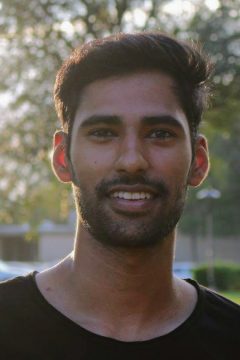Of Mice and Models: How a Graduate Student Fellow Solves Neural Puzzles
BY: ALEX JOHNSON
They say that great minds think alike, but very little is known about how thinking translates to movement or action. The brain remains one of the great puzzles of science, and many issues related to the brain, like motor diseases, are still not fully understood. Munib Hasnain enjoys solving problems above all else, and he is currently working towards his PhD in biomedical engineering at Boston University.
Hasnain was drawn to math and science at a young age, and always wanted to make a career out of the two subjects. “I got interested in engineering because I always liked science and math. But I wanted to apply the things that I learned to something real, and solve problems that are tangible,” he says.
Hasnain was first introduced to neuroscience during a research experience for undergraduates (REU) at Rice University. He was tasked with modeling different chemicals in the brain, which opened his eyes to the real-world possibilities of math. “It was the first time that I was actually using math to solve something that wasn’t a homework assignment,” Hasnain says.
As a Graduate Student Fellow at the Hariri Institute, Hasnain now works with both mathematical models and mice to study the brain. “I love studying the brain because you can answer a lot of different questions in a lot of different ways,” Hasnain states. Hasnain trains mice to perform directional licks while he captures the activity of cells in the brain called neurons. He then uses mathematical models to compare the activity of neurons when the mouse is thinking about moving, and when the mouse is moving actively.
Neuroscience research involves collecting a lot of data quickly, and computer programs can help sort and organize data efficiently. However, researchers like Hasnain need new models and programs to sort through the large amount of brain data they capture and pick out the neural activity that is relevant to answering their questions. Hansain tries to cut through all of the noise in the data by looking for either specific patterns of activity or very large amounts of activity before or during movement.
Hasnain also builds neural networks to isolate different parts of the brain’s activity. Creating the model is difficult, but once it is correct, Hasnain can tease apart how individual properties of neurons, like their firing rate, work together to initiate movement. This simplifies the brain’s complex networks so Hasnain can try to solve the puzzle of the motor pathway one piece at a time. “Once the model is made, you can ask causality questions,” Hasnain says. He can then try to determine what brain activity drives movement, and what brain activity is driven by movement.
Although teenage Hasnain would say that his favorite thing is math, he now prefers to answer neuroscience questions like these more than pure mathematical ones. “I really like understanding how something works rather than just creating tools,” he says. And Hasnain’s research has applications for understanding certain diseases that affect motor function, like amyotrophic lateral sclerosis (ALS).
A better understanding of neural pathways and how they relate to movement can be critical to fighting motor diseases. Many of these conditions occur because muscles can no longer receive signals from neurons. The more these pathways are understood, the easier it will be to manipulate them when something stops working. Once the puzzle of neural and muscle communication is solved, new drugs and therapies can be developed.
Hasnain is still in the early stages of his research, and he has to collect a lot more data before he can begin to submit his findings. However, he enjoys challenging his own brain to solve his research puzzle. “I need to think outside the box in order to apply certain techniques and treatments, there is no other way to go about it,” he says.
To learn more about the Hariri Institute’s transformational research, click here to sign up for our newsletter.
